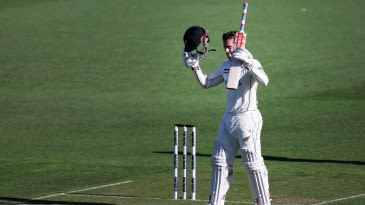
Recent Match Report – New Zealand vs West Indies 2nd Test 2020
New Zealand 294 for 6 (Nicholls 117*, Young 43, Mitchell 42, Gabriel 3-57, Chemar Holder 2-65) vs West Indies
It’s unlikely Henry Nicholls will score a scratchier, more fortune-laden hundred, but runs are runs, and they’re worth even more when they come on a greentop offering pace, bounce and seam movement. Nicholls’ innings ensured New Zealand wrested control of the second Test away from West Indies, who had begun the opening day positively with their fast bowlers, led by Shannon Gabriel in his 50th Test, enjoying the help on offer at the Basin Reserve.
At stumps, New Zealand were 294 for 6, with Nicholls batting on 117.
Nicholls, who had come to the crease some ten minutes before lunch, survived a difficult period at the start of the second session, when Alzarri Joseph peppered him with short balls from over the wicket, pitching in the left-hander’s blind spot outside leg stump and attacking the area between his hip and shoulder. There was a top-edged pull that fell in no-man’s land, a short-leg catch that didn’t stick in Shamarh Brooks’ hands, and a hooked six that could have been a catch at long leg had Jermaine Blackwood stayed on the rope rather than move some 10 yards in.
Then Gabriel and the debutant Chemar Holder, who had been the pick of West Indies’ bowlers before lunch, returned and created a rash of chances that, on another day, would have earned them more than just one wicket between them. On this day, both Gabriel – with a length ball slanted across him – and Chemar Holder – with a full one that straightened from around the wicket – found Nicholls’ outside edge only for Darren Bravo to put him down both times at first slip.
All the luck notwithstanding, there was plenty to admire about Nicholls’ innings, especially his discipline outside off stump, and the positive intent he showed when the ball was in his favoured areas: particularly against the short ball, ironically. As his innings progressed, it felt as if his early wobbles against that form of attack had led West Indies to overuse it, erroneously, especially given that their successes early in the day had come via bowling full lengths.
Gabriel had been erratic at the start of the day, straying too full and often too straight to concede 21 in his first two overs, but once he settled into a rhythm, he kept asking difficult questions of New Zealand’s batsmen.
Back at the top of the order following BJ Watling’s return, Tom Blundell gave West Indies a clear challenge to bowl full at him with his method of camping deep in the crease. Gabriel struck in the seventh over, finding a length that brought Blundell half-forward and bowling him through the gate with sharp inward movement.
Tom Latham had set the platform for a big New Zealand total in Hamilton with a 184-ball 86 that was distinguished by his willingness to leave on length. There was even more bounce available in Wellington, and Latham left a fair few balls that whizzed six inches over the top of off stump as he moved serenely – save for a blow to the elbow from a Gabriel delivery that reared from a length – to 27.
But West Indies were also more willing to try and get him to drive, even if it meant serving up the occasional half-volley. They found the perfect line and length for him in the sixth over after the drinks break, courtesy Chemar Holder. The ball was full enough to induce the drive without being full enough to feed the stroke. Then it straightened, and Latham, who was a little late getting his weight fully onto the front foot, edged behind.
That wicket brought Ross Taylor to the crease. Gabriel immediately reappeared, discomfiting Taylor with seam movement and extra bounce, hitting him on the chest before getting one to straighten in the corridor, producing a hard-hands jab that he edged behind.
At this point – New Zealand 78 for 3 and without Kane Williamson, 2.3 overs before lunch – it felt as if West Indies were slightly ahead. But through the rest of the day they let their control slip. Apart from the overuse of the short ball, they would have also been disappointed with Jason Holder’s display. Though he bowled more overs than any of his colleagues and ended the day as the only bowler with an economy rate below 3 an over, he presented surprisingly little threat in helpful conditions, often bowling a touch too short to get the edges, or a touch too wide to make the batsmen play.
Nicholls was aided in his efforts by three successive half-century stands. Will Young played a couple of pristine drives down the ground, but endured a difficult time otherwise, with the West Indies quicks attacking his weakness of a short front-and-across trigger movement that left him crease-bound and in vulnerable positions both against the full ball angled into him and the rising ball in the corridor. Gabriel delivered the perfect example of the latter, laden with away seam, to finally end Young’s stay, and pick up his 150th Test wicket.
By then he had added 70 with Nicholls, and the next two partnerships swelled New Zealand’s score by 55 and 83 respectively. Watling made 30 and looked perhaps the most fluent of New Zealand’s batsmen before chopping on to Joseph, and Daryl Mitchell showed plenty of positive intent – especially against the offspin of Roston Chase – to score 42 before being trapped in front by a blockhole ball from Chemar Holder.
By then, Nicholls had reached his sixth Test hundred, breaking a run of 13 innings without a fifty. He grew increasingly secure at the crease without ever looking entirely fluent, and it seemed entirely appropriate that he brought up his hundred with a leading edge through point while looking to work the ball through midwicket.
Karthik Krishnaswamy is a senior sub-editor at ESPNcricinfo

